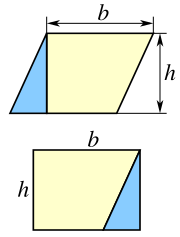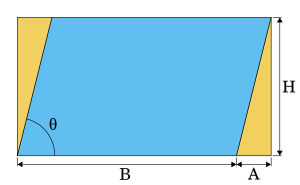Area of Polygons - Formulas
Area of Polygons
All of the area formulas for general convex quadrilaterals apply to parallelograms. Further formulas are specific to parallelograms:
A parallelogram with base b and height h can be divided into a trapezoid and a right triangle, and rearranged into a rectangle, as shown in the figure to the left. This means that the area of a parallelogram is the same as that of a rectangle with the same base and height:
The base × height area formula can also be derived using the figure to the right. The area K of the parallelogram to the right (the blue area) is the total area of the rectangle less the area of the two orange triangles. The area of the rectangle is
and the area of a single orange triangle is
Therefore, the area of the parallelogram is
Another area formula, for two sides B and C and angle θ, is
The area of a parallelogram with sides B and C (B ≠ C) and angle at the intersection of the diagonals is given by
When the parallelogram is specified from the lengths B and C of two adjacent sides together with the length D1 of either diagonal, then the area can be found from Heron's formula. Specifically it is
where and the leading factor 2 comes from the fact that the chosen diagonal divides the parallelogram into two congruent triangles.
Area of Triangle
Area of Trapezoid
The area K of a trapezoid is given by
where a and b are the lengths of the parallel sides, h is the height (the perpendicular distance between these sides), and m is the arithmetic mean of the lengths of the two parallel sides. In 499 AD Aryabhata, a great mathematician-astronomer from the classical age of Indian mathematics and Indian astronomy, used this method in the Aryabhatiya (section 2.8). This yields as a special case the well-known formula for the area of a triangle, by considering a triangle as a degenerate trapezoid in which one of the parallel sides has shrunk to a point.
The 7th-century Indian mathematician Bhāskara I derived the following formula for the area of a trapezoid with consecutive sides a, c, b, d:
where a and b are parallel and b > a. This formula can be factored into a more symmetric version
When one of the parallel sides has shrunk to a point (say a = 0), this formula reduces to Heron's formula for the area of a triangle.
Another equivalent formula for the area, which more closely resembles Heron's formula, is
where is the semiperimeter of the trapezoid. (This formula is similar to Brahmagupta's formula, but it differs from it, in that a trapezoid might not be cyclic (inscribed in a circle). The formula is also a special case of Bretschneider's formula for a general quadrilateral).
From Bretschneider's formula, it follows that
The line that joins the midpoints of the parallel sides, bisects the area.
Licensing
Content obtained and/or adapted from:
- Parallelogram, Wikipedia under a CC BY-SA license
- Triangle, Wikipedia under a CC BY-SA license
- Trapezoid, Wikipedia under a CC BY-SA license


















